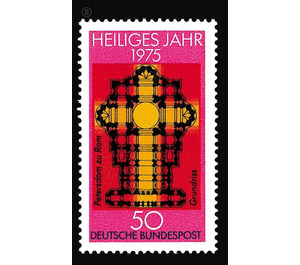Holy year 1975 - Germany / Federal Republic of Germany 1975 - 50 Pfennig
Theme: Calender
| Country | Germany / Federal Republic of Germany |
| Issue Date | 1975 |
| Face Value | 50.00 |
| Color | orange violet |
| Perforation | K 14 |
| Printing Type | Multi-color rotogravure |
| Stamp Type | Postage stamp |
| Item Type | Stamp |
| Chronological Issue Number | 723 |
| Chronological Chapter | GER-BRD |
| SID | 711085 |
| In 66 Wishlists | |
German Catholics celebrate the year 1975 as a "Holy Year" with the entire Catholic Church with the special subtitle: "Year of Reconciliation". When Pope Boniface VIII declared the year 1300 to be the "Holy Year" for the first time, he did it above all in view of the divided German and Italian politics. It was based on the model of Israel and the Old Testament and wrote - every first centenary, then from 1470 every twenty-fifth year as a "Holy Year" to make a great reconciliation possible; all ecclesiastical punishments and declarations of banns were dissolved and thus political peace was initiated. The "Holy Year" was associated with a pilgrimage to Rome, where the great reconciliation of the Church could be achieved. The pilgrimage became by itself a meeting of different nationalities in the ancient capital of the empire. It became the political "reconciliation" and the building block of Europe, whose spiritual unity without the crystallization point Rome was inconceivable. At the same time, the "Holy Year" had a cultural effect on the German lands. One recognizes in the mirror of Richard Wagner's Tannhäuser a little of the intellectual depth of the transcendent and human-bound idea of reconciliation, which then formed the heart. Most recently, the "Holy Year," Pope Pius XI. Apart from the 1933 series, it also had a fan-al and a fountain: a scandal of National Socialist terror that attacked the youthful rompilgans on their return home, and fountains of the inner resistance of religious youth to the ideology of the dictatorship. The "Holy Year 1925" as well as that of 1950 had the effect of rehabilitating the Germans after the world wars in the family of nations.


